Expect the Orioles to show up in late April early May.
If memory serves that is about when they arrived in 05 and 06.
Have not seen one hereabouts before 05.
I am 0 for 2 in getting one to my feeders.
I have offered grape jelly in a saucer and orange wedges impaled on nails after the first sighting. Maybe I should put something out earlier ?
The male perches (hides would be a better description) in the high tree crown next to the feeders, looks things over and then taunts me with his "cheep, cheep, cheep,,,your cheep call (could he be saying cheap ? smile).
He called for close to six weeks before he found his mate.
Never did see any chicks or juveniles though.
Would appreciate any ideas or suggestions.
If memory serves that is about when they arrived in 05 and 06.
Have not seen one hereabouts before 05.
I am 0 for 2 in getting one to my feeders.
I have offered grape jelly in a saucer and orange wedges impaled on nails after the first sighting. Maybe I should put something out earlier ?
The male perches (hides would be a better description) in the high tree crown next to the feeders, looks things over and then taunts me with his "cheep, cheep, cheep,,,your cheep call (could he be saying cheap ? smile).
He called for close to six weeks before he found his mate.
Never did see any chicks or juveniles though.
Would appreciate any ideas or suggestions.





